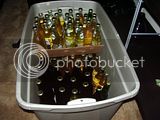I let the fermentation go for one month. I bottled...This is my very first batch. I certainly taste some other wild stuff growing. I don't mind the taste 
After only one day I opened a bottle and gave it a little shake to see what would happen. To my surprise I've got bubbles.
Should I move them to a cooler environment? Or keep the box taped shut and hope for the best?
After only one day I opened a bottle and gave it a little shake to see what would happen. To my surprise I've got bubbles.
Should I move them to a cooler environment? Or keep the box taped shut and hope for the best?











![Craft A Brew - Safale S-04 Dry Yeast - Fermentis - English Ale Dry Yeast - For English and American Ales and Hard Apple Ciders - Ingredients for Home Brewing - Beer Making Supplies - [1 Pack]](https://m.media-amazon.com/images/I/41fVGNh6JfL._SL500_.jpg)














































